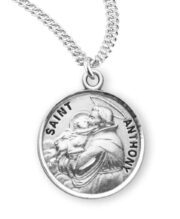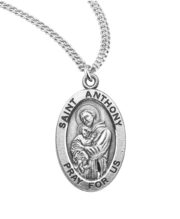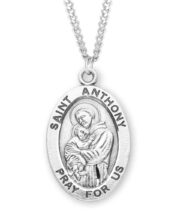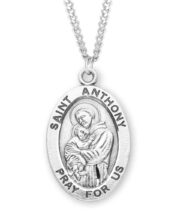Saints
St. Anthony of Padua
The Life and Miracles of St. Anthony of Padua
St. Anthony of Padua is one of the most popular and beloved saints of the Catholic Church. He is the patron saint of lost things, travelers, poor people, and many other causes. He is also known as a powerful preacher, a brilliant theologian, and a miracle worker. In this blog post, we will explore his life story, his main teachings, and some of his most famous miracles.
Early Life and Conversion
St. Anthony was born in Lisbon, Portugal, in 1195, and baptized with the name Fernando. He belonged to a noble and wealthy family, but he was not interested in worldly pleasures or ambitions. He felt a strong attraction to God and to religious life since his childhood. At the age of 15, he joined the Canons Regular of St. Augustine, a religious order that followed the rule of St. Augustine and devoted themselves to prayer, study, and pastoral work.
He spent nine years in the monastery of the Holy Cross in Coimbra, where he received a solid education in philosophy, theology, and scripture. He was ordained a priest at the age of 24, and was known for his intelligence, piety, and eloquence.
However, his life changed dramatically when he witnessed the relics of the first Franciscan martyrs who had been killed in Morocco for preaching the Gospel to the Muslims. He was deeply moved by their courage and zeal, and felt a strong desire to follow their example. He asked permission to leave the Augustinians and join the Franciscans, a new and radical order founded by St. Francis of Assisi. He took the name Anthony, after St. Anthony of Egypt, the father of monasticism.
He hoped to go to Morocco as a missionary and martyr, but God had other plans for him. On his way to Africa, he fell ill and had to return to Europe. His ship was caught in a storm and landed in Sicily, where he met some Franciscan brothers who were going to Assisi for a general chapter. He joined them and attended the meeting, where he met St. Francis himself.
Preaching and Teaching
St. Anthony remained unknown and humble among his fellow Franciscans until one day he was asked to preach at an ordination ceremony in Forli, Italy. He hesitated at first, but then he delivered a powerful and eloquent sermon that amazed everyone who heard him. He revealed his deep knowledge of scripture, his profound understanding of theology, and his fiery love for Christ.
From then on, he was recognized as a gifted preacher and teacher, and was sent by St. Francis to various places in Italy and France to proclaim the Gospel and combat heresies. He attracted large crowds of people who were eager to listen to his words and witness his miracles. He converted many sinners, reconciled enemies, healed the sick, multiplied food, freed prisoners, and even raised the dead.
He also taught theology to his fellow Franciscans, especially those who were preparing for the priesthood. He wrote several sermons and commentaries on scripture that are still considered as masterpieces of spiritual literature. He was one of the first theologians to use the method of scholasticism, which combined reason and faith in a systematic way.
He was also one of the first followers of St. Francis to receive the stigmata, or the wounds of Christ on his body. This happened in 1229, when he was praying in a secluded place near Padua. He saw a vision of the crucified Christ, who imprinted on him the marks of his passion.
Last Years and Death
St. Anthony spent the last years of his life in Padua, where he was loved and revered by the people for his holiness and miracles. He continued to preach with fervor and compassion until his health declined due to his exhausting apostolate.
He died on June 13th 1231 at the age of 36 in Arcella, near Padua. His last words were: “I see my Lord”. He was buried in Padua, where a basilica was built in his honor.
He was canonized by Pope Gregory IX less than a year after his death, on May 30th 1232. He was also declared a Doctor of the Church by Pope Pius XII in 1946.
Patronage and Devotion
St. Anthony is one of the most popular and invoked saints in the world. He is the patron saint of lost things, travelers, poor people, sailors, fishermen, mail carriers, pregnant women, and many other causes. He is also invoked for finding a spouse, for protection from danger, and for healing of various diseases.
One of the most common devotions to St. Anthony is the so-called “Thirteen Tuesdays”, which consists of praying to him every Tuesday for thirteen consecutive weeks, starting on his feast day (June 13th) or any other Tuesday of the year. This devotion is based on the tradition that St. Anthony died on a Tuesday, and that many miracles happened through his intercession on that day of the week.
Another popular devotion is the “Bread of St. Anthony”, which consists of giving bread or other food to the poor in honor of St. Anthony, who was known for his charity and generosity. This devotion is also a way of thanking St. Anthony for his favors and blessings.
St. Anthony is usually depicted holding the child Jesus in his arms, or a book, or a lily, or a loaf of bread. These symbols represent his love for Christ, his wisdom, his purity, and his care for the needy.
St. Anthony is a powerful intercessor and a faithful friend for all those who seek his help. He is also a model of holiness and virtue for all Christians who want to follow Christ more closely.
Reflection on the life of St. Anthony of Padua
The life of St. Anthony of Padua offers a profound spiritual reflection on faith, dedication, and service. Born into a noble family in Lisbon, Portugal in 1195, he was baptized Fernando. At the age of 15, he entered the Canons Regular of St. Augustine, demonstrating an early commitment to religious life.
St. Anthony’s life was marked by a deep love for scripture and an undying devotion to the poor and the sick. His expert knowledge of scripture and powerful preaching earned him a reputation as a miracle worker. Yet, it was his humility and service to others that truly defined his spiritual journey.
St. Anthony’s decision to become a Franciscan illustrates his willingness to surrender to God’s will. Despite facing challenges from the prior of the Augustinians, he left his priory and joined the Franciscan order3. This act of surrender reminds us to be open to God’s calling, even when it requires us to step out of our comfort zones.
His desire to be a witness for Christ, even expressing willingness to become a martyr, shows his extraordinary faith. However, God had other plans for him. After falling seriously ill in Morocco, he returned home, only for his ship to be blown off course during a storm. This unexpected turn of events led him to Italy, where he would spend the rest of his life serving the Church.
St. Anthony’s life teaches us that God’s plans for us may not always align with our own. Yet, if we surrender to His will and remain steadfast in our faith, we can serve His purpose in ways beyond our imagination.
St. Anthony was canonized less than a year after his death, making him one of the most quickly canonized saints in church history. His life continues to inspire us to live out our faith with courage, humility, and unwavering dedication.
As we reflect on St. Anthony’s life, let us strive to emulate his devotion to scripture, his service to others, and his unwavering faith. May we too be open to God’s calling in our lives and serve Him with humility and love.
Next up: Biography of St. Apollonia
Also check out our handmade St. Anthony of Padua Medal and St. Anthony of Padua Rosary and St. Anthony of Padua Rosary Bracelet .




















